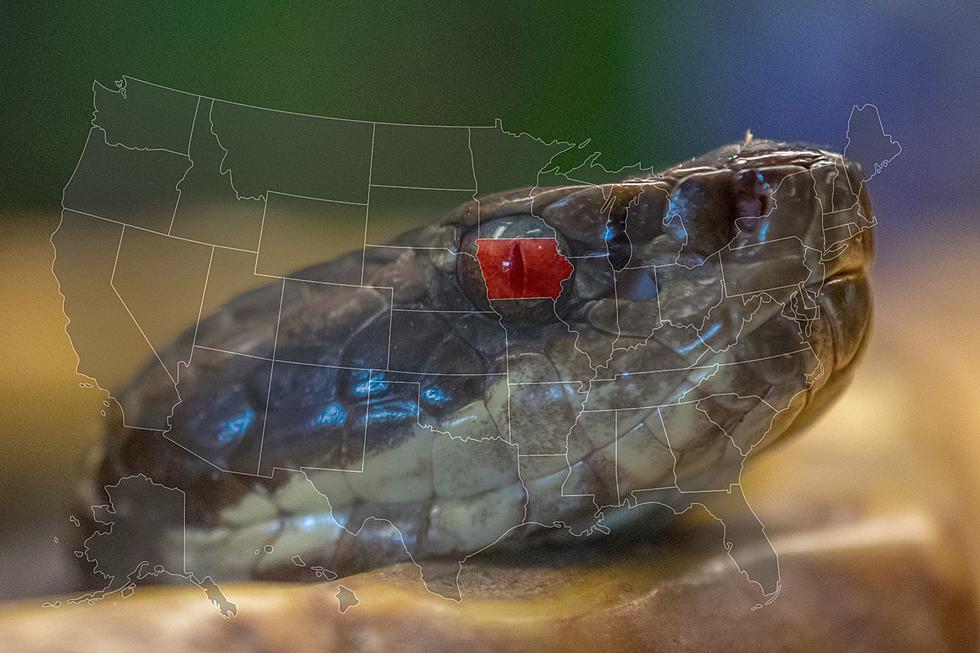
Of the 28 Snakes in Iowa, 4 Could Kill You
Hiking is one of my favorite pastimes. Being able to enjoy the beauty of the outdoors, all while getting in some much-needed exercise. Well, more than once on my hikes in and around the state of Iowa, I have come across snakes.
Can you spot the copperhead that bit a man hiking along this trail? Blends in pretty good right? See the video below...
Usually when they cross my path, its common, fairly harmless snakes like; rat snakes, hognose snakes, garter snakes, fox snakes, and the like. Occasionally though you are met with a sound so chilling that it makes the hair on the back of your neck stand up. If you have ever heard the distinctive rattling sound of Iowa's most venomous snake, you know what I'm talking about.

What Are Iowa's Most Deadly Snakes?
1) Timber Rattlesnake
First off, thank goodness this guy wants to warn you that he is around. The Timber Rattlesnake, also known as the canebrake rattlesnake, or banded rattlesnake, is among the most venomous snakes in the United States. This guy is actually a type of pit viper and packs a seriously nasty punch. Good news for you though, they are shy.
Timber rattlesnakes are found in eastern and southeastern Iowa and are protected by state laws. Their populations have declined by over fifty percent in the past 30 years. Despite their venomous nature, these snakes usually offer noticeable warnings by vibrating their rattles before striking and even feinting their bites or strikes. As mentioned above, though dangerous, they're shy and docile, usually trying to avoid humans.
Their gold, tan, brown, or gray bodies bear black chevron bands, sometimes with an additional stripe. They measure anywhere from 36-60 inches when fully grown, and possess thick bodies, spade-shaped heads, and distinctive velvet-black tails with light-colored rattles.
Rattlesnake bites are a medical emergency and can be fatal if left untreated. Bites contain both neurotoxin and hemotoxin which damage tissues and affect blood and nerves. Make sure to seek help within half an hour; if left untreated, it can lead to organ failure and death within two days.
Timber Rattlesnake Distribution
Did you know?
Timber rattlesnakes are protected in 14 of Iowa’s 99 counties, excluding within 50 yards of an actively occupied residence. All other Iowa snakes are protected in all counties, and cannot legally be collected or killed, without a specific permit.
Symptoms of a Timber Rattlesnake bite include:
- numbness in the face or limbs
- lightheadedness
- weakness
- nausea or vomiting
- sweating
- salivating
- blurred vision
- difficulty breathing
Interesting historical fact, the timber rattlesnake symbolizes American history and culture. It represented the colonies' defiance of Britain. The first Navy and Gadsden flags featured it. I mean who doesn't know the phrase "Don't Tread On Me."
2) Prairie Rattlesnake
It's unlikely that you'll be seeing this guy unless you actively go looking for him. Why? Well, prairie rattlesnakes are endangered in Iowa and inhabit the Broken Kettle Grasslands Preserve. They rely on expansive prairies for food and mates and will venture up to 6 miles from their hibernation dens to find both. Unique in the region, they grow 35-45 inches. They boast a spade-like head, light stripes on their heads, and cat-like elliptical pupils. Their coloration varies from brown to greenish-gray, adorned with dark rounded blotches.
Like with the timber rattlesnake, despite their venomous nature, they seldom strike unprovoked and prefer to feast on birds, eggs, small mammals, and reptiles. That being said they are slightly more aggressive in nature. In addition to their venom hemotoxin and its tissue-destructive effect, it also has neurotoxic properties. Though they usually spend their life on the ground, occasionally they will ascend bushes or trees. Conservation efforts are in place to safeguard this distinctive species within their limited Iowa range.
Prairie Rattlesnake Distribution
3) Massasauga Rattlesnake
This snake is a rarity and inhabits scattered pockets across the state of Iowa, occupying diverse habitats like fields, meadows, and forests. They also migrate seasonally. They dwell in uplands from April to November, venturing onto roads in late summer to hunt for prey, like rodents. During winter, they retreat to wetlands, brumating (low-energy state snakes go into in the winter) in burrows.
Habitat loss due to human actions and farming threatens their existence. With two full species, the eastern and western Massasauga, they sport grayish bodies with dark blotches, growing 18-30 inches. There is a 3rd subspecies known as the desert massasauga. The snake is distinguished by dark tail bands. They feature a spade-shaped head and can adapt to varied environments. The venom is cytotoxic, so it destroys tissue. It also contains specialized digestive enzymes that disrupt blood flow and prevent blood clotting. Severe internal bleeding causes the death of the small animals it eats. Conservation efforts are essential to protect these small and crucial members of Iowa's ecosystem.
Massasauga Rattlesnake Distribution
4) Copperhead
The copperhead is a prevalent venomous snake in the US but is endangered in Iowa due to its borderline range and only appearing around the southeast corner of the state. It's unwise to underestimate this species, as they are historically responsible for more bites than any other venomous snake in the country. They inhabit various areas, including urban spaces. With tan or copper hues, they may blend in, but watch for dark blotches, triangular heads, and 2 to 3 feet body length.
Often hunting small mammals or amphibians, these snakes pose little threat if left undisturbed. Copperhead venom has an estimated lethal dose of around 100 mg, and tests on mice show its potency is among the lowest of all pit vipers, slightly weaker than that of its close relative, the cottonmouth. The copperhead is active during the
day in spring and fall but becomes nocturnal in the hottest summer months. Caution and non-provocation are key when encountering them in Iowa.
Copperhead Distribution
What do I do if bitten by a venomous snake?
The best treatment for a rattlesnake bite is to avoid being bitten at all. That's not always possible, but when trekking through snake habitats, watch for them and listen for that spooky rattling noise. In addition, wear loose clothing and boots to combat strikes. And, here's the key, DO NOT PROVOKE THE SNAKE.
That's all fine but I've been bitten, now what?
- Stay calm. If you are bitten by a rattler or copperhead, keep yourself calm. Panicking causes your heart rate to rise, which circulates the venom more quickly. When that happens, it can make it difficult to think clearly or act appropriately.
- Leave the area. Rattlesnakes may bite the same target more than once (Yikes). If you are bitten, immediately leave the area and get at least twenty yards away from where the strike occurred.
- Rest. sit down and take a break while waiting for help, or have a friend drive you to the hospital. Sitting still keeps your heart rate low, preventing the spread of venom in your body.
- Remove jewelry or tight clothing. The area around a rattlesnake bite will most likely begin to swell as the venom spreads. any clothes or jewelry in the area may constrict blood flow. This can cause further tissue damage, so it’s important to remove anything that may constrict before the area begins to swell.
- Let the bite bleed. A little bit of blood flow from the wound is good, as it may flush out some of the venom in the process. DO NOT apply direct pressure to a bite unless a major blood vessel has been punctured and the wound is gushing or spurting blood.
- Use a clean bandage. If available, loosely apply a clean gauze bandage to the wound to keep dirt and bacteria out.
- Get to the hospital. This is your top priority, and it should be a no-brainer! Call for an ambulance or have a friend drive you. The sooner you get to the hospital, the sooner you can receive antivenom treatment and begin recovery.
WATCH OUT: These are the deadliest animals in the world
LOOK: Stunning animal photos from around the world
More From 98.1 KHAK


![Caitlin Clark and Aliyah Boston Already Looking Great! [WATCH]](http://townsquare.media/site/675/files/2024/04/attachment-Fever1-e1714056891354.jpg?w=980&q=75)
![8 Awesome Iowa Restaurants I Visited This Spring [GALLERY]](http://townsquare.media/site/675/files/2024/04/attachment-Add-a-little-bit-of-body-text-35.jpg?w=980&q=75)





